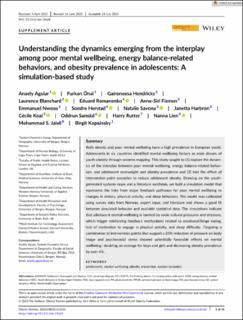| dc.contributor.author | Aguiar, Anaely | |
| dc.contributor.author | Onal, Furkan | |
| dc.contributor.author | Hendricks, Gaironeesa | |
| dc.contributor.author | Blanchard, Laurence | |
| dc.contributor.author | Romanenko, Eduard | |
| dc.contributor.author | Fismen, Anne-Siri | |
| dc.contributor.author | Nwosu, Emmanuel | |
| dc.contributor.author | Herstad, Sondre Haugsbø | |
| dc.contributor.author | Savona, Natalie | |
| dc.contributor.author | Harbron, Janetta | |
| dc.contributor.author | Cecile, Knai | |
| dc.contributor.author | Samdal, Oddrun | |
| dc.contributor.author | Rutter, Harry | |
| dc.contributor.author | Lien, Nanna | |
| dc.contributor.author | Jalali, Mohammad S. | |
| dc.contributor.author | Kopainsky, Birgit | |
| dc.date.accessioned | 2023-10-03T08:20:21Z | |
| dc.date.available | 2023-10-03T08:20:21Z | |
| dc.date.created | 2023-09-27T15:27:06Z | |
| dc.date.issued | 2023 | |
| dc.identifier.issn | 1467-7881 | |
| dc.identifier.uri | https://hdl.handle.net/11250/3093671 | |
| dc.description.abstract | Both obesity and poor mental wellbeing have a high prevalence in European youth. Adolescents in six countries identified mental wellbeing factors as main drivers of youth obesity through systems mapping. This study sought to (1) explore the dynamics of the interplay between poor mental wellbeing, energy balance-related behaviors, and adolescent overweight and obesity prevalence and (2) test the effect of intervention point scenarios to reduce adolescent obesity. Drawing on the youth-generated systems maps and a literature synthesis, we built a simulation model that represents the links from major feedback pathways for poor mental wellbeing to changes in dietary, physical activity, and sleep behaviors. The model was calibrated using survey data from Norway, expert input, and literature and shows a good fit between simulated behavior and available statistical data. The simulations indicate that adolescent mental wellbeing is harmed by socio-cultural pressures and stressors, which trigger reinforcing feedback mechanisms related to emotional/binge eating, lack of motivation to engage in physical activity, and sleep difficulty. Targeting a combination of intervention points that support a 25% reduction of pressure on body image and psychosocial stress showed potentially favorable effects on mental wellbeing—doubling on average for boys and girls and decreasing obesity prevalence by over 4%. | en_US |
| dc.language.iso | eng | en_US |
| dc.publisher | Wiley | en_US |
| dc.rights | Navngivelse-Ikkekommersiell 4.0 Internasjonal | * |
| dc.rights.uri | http://creativecommons.org/licenses/by-nc/4.0/deed.no | * |
| dc.title | Understanding the dynamics emerging from the interplay among poor mental wellbeing, energy balance-related behaviors, and obesity prevalence in adolescents: A simulation-based study | en_US |
| dc.type | Journal article | en_US |
| dc.type | Peer reviewed | en_US |
| dc.description.version | publishedVersion | en_US |
| dc.rights.holder | Copyright 2023 the authors | en_US |
| dc.source.articlenumber | e13628 | en_US |
| cristin.ispublished | true | |
| cristin.fulltext | original | |
| cristin.qualitycode | 1 | |
| dc.identifier.doi | https://doi.org/10.1111/obr.13628 | |
| dc.identifier.cristin | 2179545 | |
| dc.source.journal | Obesity Reviews | en_US |
| dc.identifier.citation | Obesity Reviews. 2023, 24 (S2), e13628. | en_US |
| dc.source.volume | 24 | en_US |
| dc.source.issue | S2 | en_US |

